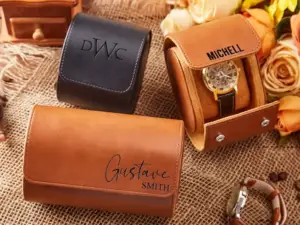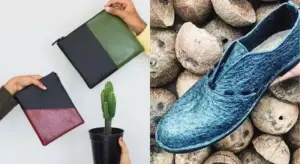Leather vs Fabric sofa with pets: Which is pet-friendly?
It’s no secret that pets and furniture don’t always mix well. Pets can scratch, claw, and bite furniture, which can lead to expensive repairs or replacements. So between leather vs fabric sofa, which is pet-friendly?
When it comes to sofas, there are many factors to consider and especially regarding their qualities.
In this article, we’ll explore the qualities and the pros and cons of fabric and leather couches to determine the best option for pet owners.

Leather vs fabric sofa with pets, which is pet-friendly?
If you have pets, leather can be a better choice compared to fabric due to its numerous advantages. For instance, leather furniture is extremely durable, easy to clean, and easy to buff off marks and scratches. Also, leather does not wear out easily since it is more resistant to scratches and tears compared to fabric.
Leather and fabric sofas have their advantages and disadvantages when it comes to pets. So it’s important to consider the following qualities when choosing your furniture.
- Durability
When it comes to choosing the right sofa for your home, there are many factors to consider. But one of the most important is durability. After all, you want your sofa to last for years to come.
So, is a leather sofa more durable than a fabric one?
In general, leather is worth it because it’s a more durable material than fabric. It’s less prone to tearing and staining, and it holds up better to heavy use.
However, the durability of leather might depend on the type of leather used. Some types of leather are more susceptible to damage than others. For instance, faux leather or polyurethane tends to scratch, rip, tear, and wear out more easily than real leather.
Fabric sofas are also available in different materials ranging from delicate silk to microfiber, chenille, suede, and polyester among others. Despite the quality, a fabric sofa is less durable than leather and may show wear and tear more quickly.
That said, even the highest quality leather can be damaged if it’s not properly cared for. So, proper care is essential to prolong the life of your leather or fabric sofa when you have pets.
Most people with pets usually protect their leather couches from pets by covering the up with a cover or throw blanket.
- Puncture resistance
Leather sofas are much more difficult to puncture than fabric sofas. This is because leather is a natural material that is stronger and tougher than fabric; hence, it holds up better to heavy use.
Fabric sofas, on the other hand, can easily be punctured by your pet’s sharp claws and cause them to rip or tear.
That said, it’s important to note that there are different grades of leather and that some are thicker and stronger than others. Full-grain leather, for instance, is heavy-duty and more resistant to punctures than thin, delicate leather.
In addition, the construction of the sofa is important. A well-built leather or fabric sofa with strong seams is less likely to be punctured than a poorly made one.
So when you’re considering a new sofa, keep these factors in mind to choose one that will best meet your needs.
- Scratch proof
There is a common misconception that leather is scratch-proof. Both sofa materials are susceptible to scratches, but leather may be harder to scratch than fabric.
This means that if you have a dog or cat that likes to scratch furniture, a leather sofa will be less likely to get scratched than a fabric sofa.

In addition, because leather is a natural material with irregularities on the surface, scratches, and scuff marks are less likely to show. So leather is more dog and cat friendly than fabric.
- Cleaning pet hair
Pet hair can be a nuisance to remove from furniture, regardless of whether the sofa is made of leather or fabric.
However, pet hair or fur tends to stick more easily on a microfiber or polyester fabric sofa than leather due to static electricity especially when humidity is low.
The fibers in the microfiber fabric create an electrostatic field, which attracts the hair. The hair then sticks to the fabric, and it can be difficult to remove.
Leather sofas are somewhat easier to clean than fabric as pet hair does not stick as much on leather. Due to the smooth surface, pet fur just collects on the corners of the leather couch and can be vacuumed up easily.
- Pet smell or odor
When it comes to pet smell or odor, both leather and fabric couches can start smelling like a dog over time. This happens if you have allowed your pets to sit and snuggle up against the sofa.
The oils and sweat from their skin or fur seep into the material and linger on the furniture causing it to smell.
Additionally, leather and fabric couches are not resistant to water or pet urine for that matter. So they can get stained by your pet’s urine or feces and start to have an odor.
This is because urine contains ammonia which is a powerful odor-causing agent while feces often contain bacteria that can produce potent smells.
To prevent the bad smell of leather, consider using a leather cleaner to clean the couch. For fabric couches, you can sprinkle baking soda onto the sofa and let it sit for a few hours before vacuuming it up.
In both cases, however, you might need a pet odor eliminator after cleaning to get rid of the smell completely.
- Comfortability
Leather is a durable, hard-wearing material that can be difficult for pets to sink their claws into or snuggle.
Pets can find leather sofas uncomfortable because the material is not soft and cushy like most fabrics. This makes it hard for them to snuggle or sleep on the sofa.
Also, leather does not absorb smells or spills like fabric sofas, which could be off-putting for pets.
Fabric sofas, on the other hand, are typically warmer than leather sofas, which makes them a better choice for pets. Leather furniture can get quite cold in the winter, while fabric sofas will help keep your pet warm.
Additionally, fabric sofas are often more comfortable for pets than leather, as they allow them to sink in and feel more supported on the couch.
- Ease of repair
Pets can cause a lot of wear and tear on furniture so it’s important to know whether or not the damage can be repaired.
Leather sofas can be repaired either through DIY or by a professional. If the damage is limited to a small area, you can use a leather patch kit to fix it. But if the damage is more widespread, you may need to have the sofa professionally repaired.
While it’s possible to repair a damaged fabric sofa using a patch kit, you might not like the result. Unlike leather patches, the fabric patch may not blend well or adhere well to the fabric of the sofa.
The most recommended solution is to reupholster the fabric sofa, which tends to be quite costly.
- Ease of cleaning and maintenance
There is no doubt that leather is easier to clean than fabric, as it doesn’t stain as easily and can be wiped down with a damp cloth and mild soap.
However, it needs to be conditioned regularly with a leather conditioner to protect it from cracking and fading.
Fabric sofas on the other hand are the most difficult to clean and maintain than leather, as they can easily become stained or faded.
To clean a fabric sofa, you will need to use a special fabric cleaner or detergent. Fabric sofas also need to be vacuumed regularly to remove any hair or dust that may accumulate.
- Cost
That said, I believe your budget is also a determining factor when choosing your couch.
Leather couches are typically more expensive than fabric couches. This is because leather furniture requires a higher level of craftsmanship and is made from more expensive materials.
The furniture also lasts longer than other materials and is easier to clean and maintain.
On the other hand, fabric couches are less durable and require more frequent cleaning and maintenance.
So, if you’re looking for a long-lasting, high-quality couch that will add a touch of luxury to your home, then a leather couch is the best option. But you should be prepared to pay a bit more for it.
Pros and Cons of leather vs cloth couch for dogs
| Quality | Leather Sofa | Fabric Sofa |
| Durability | More durable and resistant to wear and tear | Less durable and prone to staining and fading over time |
| Puncture resistance | High | Low to medium |
| Scratch proof | High | Low to medium |
| Cleaning pet hair | Easy to clean, hair doesn’t stick | Hair sticks, harder to clean |
| Pet smell/Odor | Absorbs odors but can be cleaned easily |
Absorbs odors and may be harder to clean |
| Comfortability | Not very comfortable for people and pets | More comfortable for pets than leather |
| Ease of Repair | Easy to repair with DIY techniques | Harder to repair |
| Maintenance | Easy to clean and maintain | Requires more frequent cleaning and maintenance, |
| Cost | More expensive than fabric | Less expensive than leather |
Is leather or faux leather better for dogs?
While the decision to get real leather or faux leather couch lies with the pet owner, there are some pros and cons associated with the two types of leather.
Faux leather for instance is thinner than real leather and tends to scratch and tear easily. So, it might be able to withstand the claws of your dog and frequent licking.
Real authentic leather, on the other hand, is durable, thick, and tough enough making it unlikely to get punctured by your dog’s nails.
Both real leather and faux leather however do not absorb spills and can be cleaned by wiping down with a soft cloth.
Ultimately, it is up to you as a dog owner to decide what type of leather you feel is best for your pet.
Conclusion
Are you still wondering which the best pet-friendly sofa material is? Well, from the qualities above, leather sofas seem to be more pet-friendly than fabric sofas.
This could be attributed to the fact that leather is easier to clean and maintain, and does not puncture or scratch easily compared to fabric.
Furthermore, fabric sofas can also trap allergens, which can be harmful to pets and people alike.
If you’re looking for a new sofa that will accommodate your furry friends, we recommend going with a leather one.





